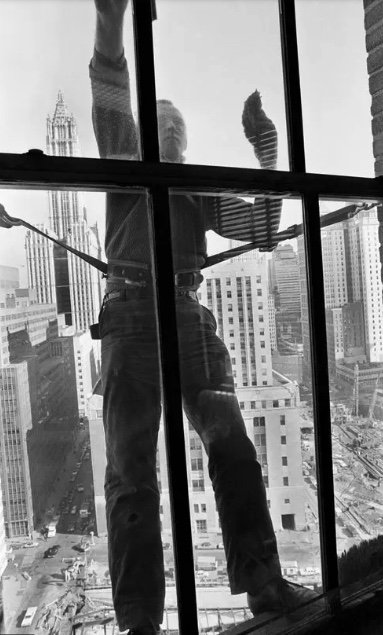The New York World newspaper building was the tallest in NYC in 1890.
When the buildings in New York City began to rise ever higher to twenty stories in the late 1800s, that meant the windows were higher, too. Located on, “Newspaper Row,” the New York World Building was designed in the Rennaissance Revival style by architect George Browne Post and constructed in 1890.
A 1906 advertisement for window cleaning anchor bolts and safety harnesses.
At 309’, this was the tallest building in NYC at the time. With the dome spire soaring up at 350’, this eclipsed the 284’ spire of Trinity Church on Wall St.
It was also considered to be the tallest building in the world. And someone had to go up there and clean all of those windows.
A man cleaning windows using a harness strapped to window anchor bolts.
When buildings were rarely over 5 stories tall, the window cleaner would climb out the window and stand on the ledge, with one hand gripping the frame for balance.
They would simply hang on to the façade of the building without any rope for safety or being tethered in any way. As buildings rose ever higher, this method of window cleaning was no longer viable.
After any number of fatalities, safety became an overarching issue. This is when belt work was begun. Buildings incorporated anchor bolts on either side of each window and leather safety belts were attached with clips.
The cleaner was effectively in a sling that held his back far above the city street. His feet were still on the windowsill, but now there was a physical tethering to the building. Falls were less likely. However, the window washers were only as secure as the anchor bolts holding them.
A man doing belt work in a harness clipped to window anchor bolts.
In more modern times, with the advent of scaffolding lifts for window washers, architects often had these bolts removed for the sake of aesthetics and to give the façade a clean, flush appearance.
However, if a building is landmarked, this alteration is not an option. All components of the building and façade must remain as they were in the 1940s tax photographs.
Window cleaner anchor bolts are still manufactured and sold today. With innovations in modern architectural windows, not all buildings can be accessed with the conventional lifts.
Some buildings require unique rigging systems. And these rigging systems require anchor bolts.
Proof once more that everything that’s old is brand new again.




